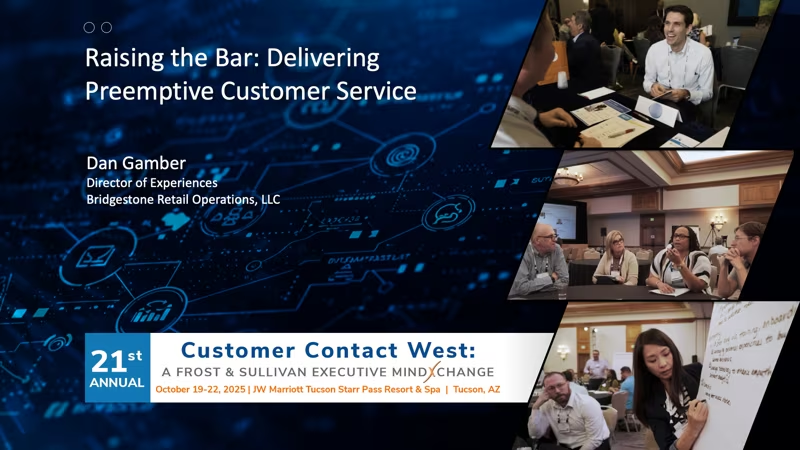At the 18th Annual Customer Contact East: A Frost & Sullivan Executive MindXchange, participants chose between six interactive brainstorming sessions and crowdsourced solutions to some of today’s most pressing customer service challenges. Read on for key ideas and suggestions generated from three of six sessions — great insights and ideas you can implement right now:
The Fix on Accelerating Vendor Selection and Technology Implementation
Moderated by Francoise Benoit-Betters, Vice President, Merchant Services, First American by Deluxe
Start by asking for a Proof of Concept – a 6 -to- 8- week engagement where they will demonstrate product. If a vendor is unwilling to share references, it could be a red flag. Caveat: Security – geographic, data classification, outside forces (contracts, compliance, regulation) has an impact on data.
Vendor Selection:
- Begin with requirements for your project. You may be able to use your internal resources instead of having external ones
- Complete research through G2 crowd (website) – the site provides questions to ask vendors
- Define the problem you are trying to solve
- What are the benefits the vendor is able to provide?
- What are the capabilities of the vendor and do they meet your needs?
- Make a list of all must/need/nice to have items and prioritize them to the vendor?
- Are there any gaps in the vendors’ technology when implementing their software to customers?
- Inquire: How many customers do they have, when was the last time they implemented their services to a new customer versus the last existing customer?
- Select several vendors and compare costs, system requirements, API options, etc.
- Evaluate the value of the vendor’s engineering and if it will provide a sufficient ROI
- Verify what integrations are needed and how the product will be implemented
- What is the timeline for implementation?
- Ask questions during the initial call and schedule a follow up after a demo with additional questions
Technological Implementation:
- Build/customize the product for the organization
- Verify who will maintain the software application
- Confirm how often software updates are completed
- Are the customers notified of software updates?
- Verify if your organization will need to have an FTE after implementation or only a SME
- Complete beta testing
- Create training documents and train employees
- Augmentation
- Build reporting/metric data
- Build baselines
- Create a project plan with a detailed timeline
Steps for securing sensitive data:
- Identify
- Detect
- Protect
- Backup
- Recovery
The Fix on Business Continuity
Moderated by Chris Goostree, Director of Contact Center Operations, TMX Finance Family of Companies
Chris Goostree began this session by telling a story. He began working for his previous employer in February 2020, and a month later they sent 3 sites, and over 500 people home in less than 2 weeks. He had 5 managers, 4 of which did standard Outbound Call Center work, and 1 who did our Alternative Retrieval work. Her team called doctor’s offices to gain access to data systems to retrieve medical charts directly. With the transition to work-from-home, his focus was with the other four managers who led 90% of the staff.
In early October of 2020, the manager of the Alternative Retrieval Department passed away suddenly. She had two team leads, one was new, the other was a subject matter expert but not qualified for leadership. The lesson was that single points of failure can sink an organization. Chris spent the next two months running the department himself, along with his day job of being Director and trying to appease a very demanding client with whom he would spend 10+ hours on the phone with a week. Team moral, production, and effectiveness dropped during this time.
Group 1: Talked about combating a single point of failure (SPOF) by having T-shaped individuals. This is a concept where you hire someone for their expertise, yet cross train them to help fill gaps needed through the organization.
- Redundancy was a topic for sites, personnel, and systems.
- Extremes in leadership was a concern for business process continuity with this group.
- Hands off leaders don’t understand enough of the process to be an effective stopgap)
- Heavy bureaucracy ties the hands of others stepping in with red tape.
Group 2: Built on the feedback, focusing in on support. Corporate support desks such as Marketing, Development, HR and others tend to have fixed business hours (Mon-Fri 8-5). What happens outside those hours when the company’s hours of operation may be 24/7? This group focused on having a well thought out escalation path. Being able to network with these departments was another option, to have a contact to reach out to when needed.
Group 3: Focused on communication. Having a self-service option to fall back on for customers and/or employees. The quote from this group: “Never waste a good crisis” – use events where continuity was needed to apply the lessons learned to future continuity needs. Not wasting a process/technology change was a part of this discussion as well. Use upgrades as a time to test your plan.
Group 4: Focused on the task of updating BCPs and how to start a herculean effort of writing one to begin with. This discussion centered around leaning on resources including those who roll out changes/upgrades.
Group 5: Build on communication by making sure that you test and periodically retest your plan. The inspiration here was tornado/fire drills in school. Make sure everyone knows what to do when the time comes.
Group 6: Focused on limiting customer/client impact, and then focusing on employee impact. Prioritizing recovery points for those that have centers involved in life critical call types.
Each group stepped away with a new view on business continuity. Eliminating the single point of failure be it a person, place, or system takes planning, communication, and follow through. In the post Covid world many centers work from home and while that might limit some of the physical redundancies, it creates other continuity issues that we are just starting to uncover three years in.
The Fix on Elevating Women in Leadership
Moderated by Hannah Day, Director of Revenue Management and CRO Operations, Paramount Hospitality Management, LLC
Problem:
Finding and developing diverse applicants, seeing women primarily in mid-level leadership positions (managers, directors, etc.), but not in C-level leadership roles.
Suggestions:
- Reach out to the community advertising the role; applicants may need encouragement if the job posting itself isn’t attracting a large pool of applicants
- Leverage a hiring panel consisting of different leaders to properly evaluate candidates and help applicants feel more comfortable
- Require hiring teams to interview a specific number of male and female applicants of different backgrounds/ethnicities
- Go out of your way to notice talent in other departments that could be applied better in other roles and speak up
- C-level leadership, particularly other women, should consider acting as a mentor to mid-level leaders and entry level employees
- Have career conversations with the women in your company, as often employees may feel uncomfortable or unsure speaking about their goals
Problem:
Attracting women to roles in heavily male-dominated companies. Women can become discouraged through the interview process when the majority are male
Suggestions:
- Create a hiring panel with a women leader from a different department
- If no female leaders exist within the company, try partnering with a female leader in the community who can be on the hiring panel and be a resource to the employee
- Have focus groups within the community to brainstorm ideas about how to encourage women applicants (applies to encouraging diverse applicants)
Problem:
Unconscious gender bias
Suggestions:
- Get educated about how different gender’s brains and decision processes work. Neither gender is better but they are different
- Ensure concern is shown about addressing historical bias/stereotypes
- Provide tools to help all employees balance their family life
- Solving this starts with equal benefits so others (primarily men) feel empowered to take part in balancing the home life
Examples include providing paternity leave as well as maternity leave, flexibility and empathy for the employees’ home life, and resources specific to assisting single parents of either gender



